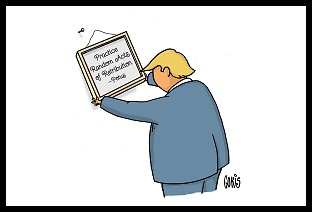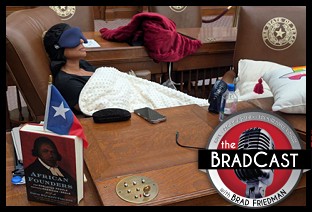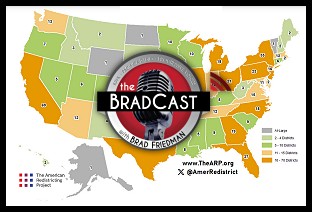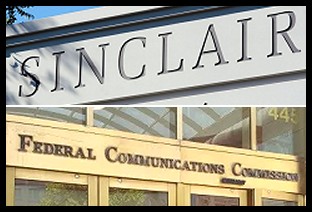Guest blogged by Ellen Theisen, VotersUnite.Org
Over two years ago, the U.S. Justice Department filed a lawsuit against New York State to force the state to comply with the federal requirement to equip every polling place with voting systems that are accessible to people with disabilities, as mandated by the Help America Vote Act of 2002 (HAVA).
Meanwhile, the DoJ has taken no action at all to stop any state from using voting equipment that has been proven to violate HAVA’s requirement for accurate vote-counting.
While it's important for every citizen, disabled or not, to be able to vote privately, a private vote is meaningless if that vote is not counted accurately. Despite the equal weight HAVA gave to both important mandates, the federal requirement for accurate vote-counting is being wholly ignored by the states, and even the federal government.
Two recent incidents which have been making headlines --- in New Jersey and Ohio --- illustrate clear, undeniable violations of the federal accuracy requirement. They are impossible to deny or ignore. For the moment, however, federal officials are doing exactly that...
Sequoia E-Voting Machines Miscount in Six New Jersey Counties...
New Jersey election officials discovered discrepancies in the 2008 primary election summary reports of 60 of their Sequoia Advantage touch-screen e-voting machines. Sequoia blamed the discrepancies on poll worker error, but subsequent discoveries disprove the company’s explanation.
One of the Sequoia Advantage vote summary tapes from Englewood Cliffs, District 4, in Bergen County, New Jersey showed 106 votes cast by 105 ballots. In addition, the automatic counter on the machine showed only 105 voters. (At least one other machine reported the same types of discrepancies.) Princeton computer science professor Ed Felten offers more details and photos of the tapes here.
Since the machine counter matches the total number of Republican and Democratic ballots cast, it appears that the machine added one vote to the totals for one of the candidates. In this case, the error rate on the Englewood Cliffs Sequoia Advantage machine was over 60,000 percent higher than the maximum error rate allowed by HAVA.
Section 301(a)(5) of HAVA spells out the mandatory standards for error rates on voting systems. It says:
Section 3.2.1 of the 2002 Voluntary Voting System Standards, which were in effect when HAVA was enacted, defined the accuracy requirements for DREs as follows:
The “maximum acceptable error rate” of one in 500,000 ballot positions (choices on a ballot) is an error rate of 0.0002%. But the error rate for the Advantage machine was 0.12%, which is the number of miscounted votes (1) divided by the number of possible choices on all ballots.
That error rate is more than 600 times as high (or 60,000%) as the maximum error rate allowable under by federal law.
Diebold/Premier E-Voting System Miscounts in Butler County, Ohio...
In a letter sent this week from Butler County, OH election officials, it was revealed that on March 4, 2008, the Diebold GEMS central tabulator failed to upload and store 105 ballots recorded on their AccuVote touch-screen voting machines, even though the system reported that all the ballots on the 1,599 memory cards had been uploaded successfully. The elections website of Butler County (which has since corrected the GEMS error) reports that 94,053 ballots were cast in the election.
The 105 ballots missed by the GEMS upload software represent from 0.08% to 0.18% of the ballot positions counted by the system (depending on the proportion of Democratic to Republican ballots stored on the memory card – there were nearly twice as many contests on the Republican ballot). But remember, HAVA allows a maximum error rate of 0.0002%. This means the error rate on the Butler County GEMS server was between 400 and 900 times as high (40,000% to 90,000%) as the rate allowed by federal law.
Now that these facts are known, using New Jersey’s version of the Sequoia Advantage e-voting machines or Butler County’s version of the Diebold AccuVote/GEMS system (v.1-18-24.0) in the November 2008 election would be a violation of federal law.
But the problem may be even more serious. The bugs that caused the miscounts have not yet been found or analyzed. Since software bugs are typically carried forward from one software version to the next unless they are found and fixed, these same bugs may very well be present on all Sequoia Advantage e-voting machines and all versions of Diebold GEMS (which is used to accumulate vote totals from Diebold/Premier's paper-based optical scan systems, as well as from their touch-screen e-voting machines).
So, it is quite possible that any jurisdiction using the Sequoia Advantage or Diebold GEMS could well be in violation of federal law if those same systems are used in November.
These are just two recent examples, from within the last two months, of vote-counting errors on electronic equipment far beyond the the rate allowable by law. Dozens of such incidents, reported all across the country, have occurred in every recent election cycle.
How long will the Justice Department, the U.S. Election Assistance Commission (EAC), and states continue to ignore the mandate of HAVA --- and more importantly, the mandate of democracy --- for accurate vote-counting?
CORRECTION: Due to information discovered after our initial publication of this story, it was necessary to recalculate the error rates reported above. While the initial article had reported error rates as high as "half a million percent," the numbers have now been adjusted to note a somewhat lower error rate, though one which is still far in excess of that allowable by law. Theisen has post a detailed description of how she derived the above numbers in comments below.
UPDATE 4/15/08: The state of NJ declares the numbers aren't what they seem to be --- and what even the counties thought they were --- on the official paper audit trail tapes from the state's Sequoia touch-screen systems, adding what appears to be yet another violation of HAVA to the points already made above. Full details now here...
UPDATE 4/16/08: "Bacchus" at the Guerrilla News Network links up to this article, and adds the following insightful preamble to their coverage:
According to my calculations, if I were driving 40,000 percent drunker than the legal limit, my blood would be about 64 proof. Not even Jesus can compete with that! If I were driving 40,000 percent faster than the legal speed limit, I estimate that I’d be driving at about mach 32, or here to the moon in nine hours.
But if I were voting on a machine with an error rate 40,000 percent higher than the legal limit? Why, I must be an American!


 Sunday 'Random Acts of' Toons
Sunday 'Random Acts of' Toons From CA's 'Nuclear Deterrence' Map to Newsom's Trolling to Trump's 'Fascist Theatre' and Beyond: 'BradCast' 8/21/25
From CA's 'Nuclear Deterrence' Map to Newsom's Trolling to Trump's 'Fascist Theatre' and Beyond: 'BradCast' 8/21/25 'Green News Report' 8/21/25
'Green News Report' 8/21/25
 On 'Americanism' and Trump's 'Stalinesque' Plot to Whitewash U.S. History: 'BradCast' 8/20/25
On 'Americanism' and Trump's 'Stalinesque' Plot to Whitewash U.S. History: 'BradCast' 8/20/25  Texas GOP Imprisons Dem State Lawmaker in State House Chamber: 'BradCast' 8/19/25
Texas GOP Imprisons Dem State Lawmaker in State House Chamber: 'BradCast' 8/19/25 'Green News Report' 8/19/25
'Green News Report' 8/19/25 Trump, Nazis and
Trump, Nazis and  Sunday '
Sunday ' Newsom's 'Election Rigging Response Act'; FCC's License Renewal for Sock-Puppeting Sinclair: 'BradCast' 8/14/25
Newsom's 'Election Rigging Response Act'; FCC's License Renewal for Sock-Puppeting Sinclair: 'BradCast' 8/14/25 'Green News Report' 8/14/25
'Green News Report' 8/14/25 140 New House Reps?: Moving Beyond the Gerrymandering Wars: 'BradCast' 8/13/25
140 New House Reps?: Moving Beyond the Gerrymandering Wars: 'BradCast' 8/13/25 FCC Renews Sinclair TV Licenses Despite Complaint from Petitioner Who Died Waiting
FCC Renews Sinclair TV Licenses Despite Complaint from Petitioner Who Died Waiting It's Not About the Rule of Law, It's About Authoritarian Control: 'BradCast' 8/12/25
It's Not About the Rule of Law, It's About Authoritarian Control: 'BradCast' 8/12/25 'Green News Report' 8/12/25
'Green News Report' 8/12/25 After Vaccine Cancels, CDC Shooting, Former Officials Want RFK Out: 'BradCast' 8/11/25
After Vaccine Cancels, CDC Shooting, Former Officials Want RFK Out: 'BradCast' 8/11/25 Sunday 'All's Well' Toons
Sunday 'All's Well' Toons 'Green News Report' 8/7/25
'Green News Report' 8/7/25 Trump Wars Against Greem Energy, Democracy on VRA's 60th: 'BradCast' 8/7
Trump Wars Against Greem Energy, Democracy on VRA's 60th: 'BradCast' 8/7 Media Conglomerates Continue Trump Capitulation: 'BradCast' 8/6/25
Media Conglomerates Continue Trump Capitulation: 'BradCast' 8/6/25 Banana Republican: Trump Shoots the Labor Statistics Messenger: 'BradCast' 8/5/25
Banana Republican: Trump Shoots the Labor Statistics Messenger: 'BradCast' 8/5/25 All's Fair in Love, War and, Apparently, Part-isan Gerrymandering: 'BradCast' 8/4/25
All's Fair in Love, War and, Apparently, Part-isan Gerrymandering: 'BradCast' 8/4/25 The Art of the Corrupt, Phony, Unlawful, Pretend Trade Deal: 'BradCast' 7/31/25
The Art of the Corrupt, Phony, Unlawful, Pretend Trade Deal: 'BradCast' 7/31/25 Battle Begins Against Trump EPA Climate Regulations 'Kill Shot': 'BradCast' 7/30/25
Battle Begins Against Trump EPA Climate Regulations 'Kill Shot': 'BradCast' 7/30/25 A Pu Pu Platter of Trump Corruption: 'BradCast' 7/29/25
A Pu Pu Platter of Trump Corruption: 'BradCast' 7/29/25 'Catastrophic' GOP Cuts to Medicaid, Medicare, ACA: 'BradCast' 7/28/25
'Catastrophic' GOP Cuts to Medicaid, Medicare, ACA: 'BradCast' 7/28/25
 VA GOP VOTER REG FRAUDSTER OFF HOOK
VA GOP VOTER REG FRAUDSTER OFF HOOK Criminal GOP Voter Registration Fraud Probe Expanding in VA
Criminal GOP Voter Registration Fraud Probe Expanding in VA DOJ PROBE SOUGHT AFTER VA ARREST
DOJ PROBE SOUGHT AFTER VA ARREST Arrest in VA: GOP Voter Reg Scandal Widens
Arrest in VA: GOP Voter Reg Scandal Widens ALL TOGETHER: ROVE, SPROUL, KOCHS, RNC
ALL TOGETHER: ROVE, SPROUL, KOCHS, RNC LATimes: RNC's 'Fired' Sproul Working for Repubs in 'as Many as 30 States'
LATimes: RNC's 'Fired' Sproul Working for Repubs in 'as Many as 30 States' 'Fired' Sproul Group 'Cloned', Still Working for Republicans in At Least 10 States
'Fired' Sproul Group 'Cloned', Still Working for Republicans in At Least 10 States FINALLY: FOX ON GOP REG FRAUD SCANDAL
FINALLY: FOX ON GOP REG FRAUD SCANDAL COLORADO FOLLOWS FLORIDA WITH GOP CRIMINAL INVESTIGATION
COLORADO FOLLOWS FLORIDA WITH GOP CRIMINAL INVESTIGATION CRIMINAL PROBE LAUNCHED INTO GOP VOTER REGISTRATION FRAUD SCANDAL IN FL
CRIMINAL PROBE LAUNCHED INTO GOP VOTER REGISTRATION FRAUD SCANDAL IN FL Brad Breaks PA Photo ID & GOP Registration Fraud Scandal News on Hartmann TV
Brad Breaks PA Photo ID & GOP Registration Fraud Scandal News on Hartmann TV  CAUGHT ON TAPE: COORDINATED NATIONWIDE GOP VOTER REG SCAM
CAUGHT ON TAPE: COORDINATED NATIONWIDE GOP VOTER REG SCAM CRIMINAL ELECTION FRAUD COMPLAINT FILED AGAINST GOP 'FRAUD' FIRM
CRIMINAL ELECTION FRAUD COMPLAINT FILED AGAINST GOP 'FRAUD' FIRM RICK SCOTT GETS ROLLED IN GOP REGISTRATION FRAUD SCANDAL
RICK SCOTT GETS ROLLED IN GOP REGISTRATION FRAUD SCANDAL VIDEO: Brad Breaks GOP Reg Fraud Scandal on Hartmann TV
VIDEO: Brad Breaks GOP Reg Fraud Scandal on Hartmann TV RNC FIRES NATIONAL VOTER REGISTRATION FIRM FOR FRAUD
RNC FIRES NATIONAL VOTER REGISTRATION FIRM FOR FRAUD EXCLUSIVE: Intvw w/ FL Official Who First Discovered GOP Reg Fraud
EXCLUSIVE: Intvw w/ FL Official Who First Discovered GOP Reg Fraud GOP REGISTRATION FRAUD FOUND IN FL
GOP REGISTRATION FRAUD FOUND IN FL

































